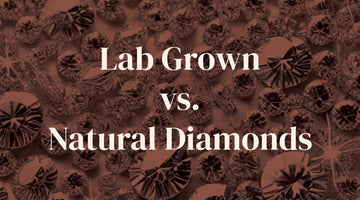Diamonds are the timeless symbols of love, commitment, and luxury. They've dazzled in the world of jewelry, starred in countless romantic comedies, and even played key roles in heist films. But as we march further into the 21st century, the age-old allure of diamonds has found a new contender: lab-grown diamonds. This has sparked a debate as intense as whether pineapple belongs on pizza. So, let's put on our gemologist hats and investigate into the glittering world of lab-grown versus natural diamonds to see what all the fuss is about.
Also Read: Real vs. Fake Diamond: A Sparkling Showdown
The Origins: Nature vs. Nurture
Natural Diamonds: The Earth's Ancient Treasures
Natural diamonds are like the epic heroes of geology, with origins that trace back over billions of years. These gems are formed deep within the Earth's mantle under conditions of intense heat and pressure. Imagine the Earth's core as the ultimate pressure cooker, baking these diamonds over eons until they’re pushed to the surface by volcanic eruptions. It’s a process so dramatic, it could be the plot of a sci-fi blockbuster.
When you hold a natural diamond, you’re not just holding a shining and glamorous stone—you’re holding a piece of Earth's history, a relic from a time when dinosaurs roamed the planet. It’s like owning a piece of the past, something that connects you to the very beginnings of our world. No wonder they’re often the centerpieces of grand declarations of love.
Lab-Grown Diamonds: The Marvels of Modern Science
Lab-grown diamonds, on the other hand, are the result of human ingenuity. These diamonds are crafted in laboratories using two main techniques: High Pressure High Temperature (HPHT) and Chemical Vapor Deposition (CVD). If this sounds like something out of a science experiment, that’s because it is. But instead of creating a science fair volcano, scientists are creating diamonds with the same physical, chemical, and optical properties as their natural counterparts. It’s like baking a perfect cake—if that cake were made of pure carbon atoms.
Despite their high-tech origins, lab-grown diamonds are 100% real diamonds. They’re not knock-offs or cubic zirconia masquerading as the real deal. Lab-grown diamonds are so indistinguishable from natural diamonds that even experienced jewelers need specialized equipment to tell them apart. If natural diamonds are the classic blockbuster movies, lab-grown diamonds are the high-definition remakes—equally captivating but produced with the latest technology.
Also Read: Platinum or Diamond: Which One Will Leave Your Wallet Weeping
The Key Differences: Lab-Grown Diamonds vs. Real Diamonds
Now that we’ve set the stage, let’s get into the action of what sets lab-grown diamonds and natural diamonds apart.
1. The Origin Story: Nature's Patience vs. Human Precision
- Natural Diamonds: Formed over billions of years, natural diamonds have a backstory that’s as rich and complex as any epic saga. They’re the original gems, shaped by the Earth’s immense forces and time itself. Each natural diamond is unique, a one-of-a-kind creation that carries with it the weight of history.
- Lab-Grown Diamonds: Lab-grown diamonds, by contrast, are created within weeks or months in a lab. While they lack the ancient allure of natural diamonds, they’re a testament to human innovation. They’re like the modern-day superheroes of the diamond world—born in labs but with all the power and beauty of their natural counterparts.
2. Environmental Impact: A Greener Sparkle
- Natural Diamonds: The process of mining natural diamonds can be as destructive as it is fascinating. Extracting these gems from the Earth often leads to significant environmental degradation, including habitat destruction, water pollution, and a hefty carbon footprint. It’s like watching a villain in an action movie laying waste to everything in their path—except this is real life, and the stakes are much higher.
- Lab-Grown Diamonds: If natural diamonds are the villains in this environmental tale, lab-grown diamonds are the heroes. Their production requires less energy and water, and because they’re made in controlled environments, there’s no need to tear up the Earth to find them. They’re the eco-friendly option, perfect for those who want their bling without the environmental sting.
3. Cost: How Much for That Diamond in the Window?
- Natural Diamonds: With their ancient origins and the cost-intensive mining process, natural diamonds come with a hefty price tag. They’re like the designer handbags of the gem world—beautiful, exclusive, and a serious investment.
- Lab-Grown Diamonds: Lab-grown diamonds, on the other hand, are generally 20-40% less expensive than natural diamonds. It’s like getting the latest tech gadget at a discount—same performance, lower price. This makes them an attractive option for those who want the sparkle without breaking the bank.
4. Appearance: Can You Spot the Difference?
- Natural Diamonds: Visually, natural diamonds and lab-grown diamonds are virtually identical. Both have that signature sparkle, fire, and brilliance that make diamonds so mesmerizing. They catch the light in the same dazzling way and look equally stunning in any setting.
- Lab-Grown Diamonds: Unless you’re a gemologist armed with advanced testing tools, you won’t be able to tell the difference between a lab-grown diamond and a natural one. They both pass the eye test with flying colors, making them equally appealing for those special moments.
5. Resale Value: An Investment or a Splurge?
- Natural Diamonds: Historically, natural diamonds have held their value well over time, making them not just a symbol of eternal love but also a solid investment. They’re like the rare collectible items of the gemstone world—something you can pass down through generations.
- Lab-Grown Diamonds: While lab-grown diamonds are still valuable, they don’t hold the same resale value as natural diamonds. Think of them as a stylish accessory rather than a long-term investment. They’re perfect for those who prioritize style and sustainability over potential resale.
Also Read: Shining a Light on Lab-Grown Diamonds: What, How, and Are They Real
The Pop Culture Influence: Lab-Grown Diamonds Are Making Waves
In recent years, lab-grown diamonds have been making a splash in the fashion world, thanks to endorsements from celebrities and influencers. It’s like when indie bands suddenly become mainstream—lab-grown diamonds have gone from niche to chic.
For instance, Emma Watson, known for her role in Harry Potter and her activism for sustainable fashion, famously wore a lab-grown diamond ring on the red carpet. This wasn’t just a fashion statement; it was a declaration that lab-grown diamonds are a serious contender in the world of luxury jewelry. In TV shows like The Good Place, where characters often grapple with ethical dilemmas, it’s easy to imagine lab-grown diamonds being part of the conversation about doing good in a complex world.
Even in the world of movies, where diamonds often symbolize luxury and exclusivity, the shift towards lab-grown diamonds is gaining traction. Imagine a reboot of Breakfast at Tiffany's where Audrey Hepburn’s character is shopping for lab-grown diamonds instead. It’s a subtle yet powerful nod to the changing times.
The Final Conclusion: Which Diamond Reigns Supreme?
So, when it comes to lab-grown diamonds vs. natural diamonds, which should you choose? The answer depends on your values, priorities, and what you want your diamond to represent.
- Natural Diamonds: If you’re captivated by the romance of owning a piece of the Earth’s history, natural diamonds might be your gem of choice. They’re like the classic novels of the diamond world—timeless, rare, and filled with stories that span the ages.
- Lab-Grown Diamonds: If you’re more inclined towards sustainability, innovation, and getting the most bling for your buck, lab-grown diamonds are the way to go. They’re like the latest bestsellers—fresh, exciting, and perfectly in tune with the modern world.
At the end of the day, whether you choose a lab-grown diamond or a natural diamond, what matters most is that it reflects your personality and values. After all, diamonds might be forever, but the choice is uniquely yours.

